In the last few months new phrases have entered the English language and in a short space of time have come to feel familiar. One phrase, perhaps more than any other, stands out, and that is social distancing. We have all been learning how to safely keep our distance from one and other and staying home, all the while yearning to be outside. Fortunately, there is somewhere that will satisfy your yearning for nature and yet has respected the idea of social distancing for millennia, Namibia.
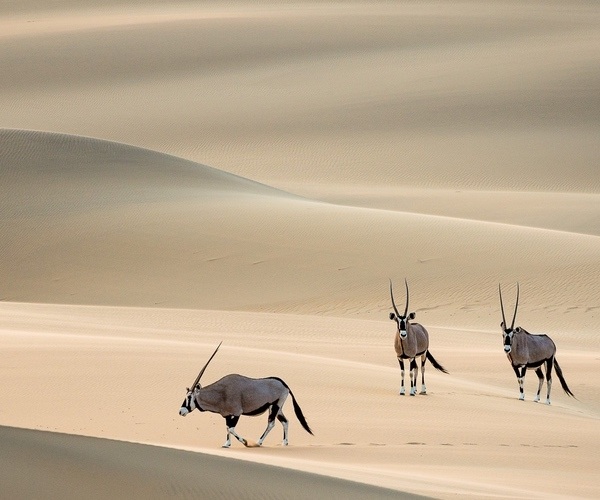
Often referred to as the Land of Wide-Open Spaces Namibia is one of the least densely populated countries in the world and getting away from it all and from everyone else is easily done!
If you are not quite yet ready to face the realities of the busy, modern world again, we have some amazing sanctuaries for you to escape real life for just a little longer.
Wolwedans Private Camp
Languishing in a vast valley in the middle of the world’s oldest desert lies the enchanting Wolwedans Private Camp, a haven of exclusivity. This is luxury in simplicity. As the name suggests, every booking at the camp is on a private basis, catering to a maximum of six guests in three en-suite rooms, perfect for families, honeymooners and those just seeking absolute solitude.
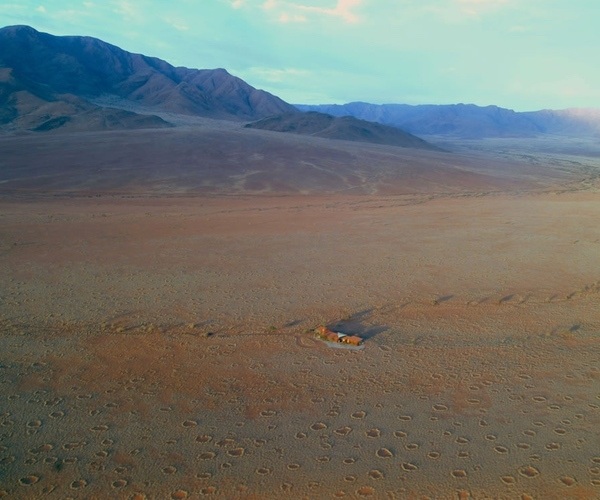
Built in a classic desert safari style with sturdy wooden poles, rugged canvas sidings and bedecked in a muted palette of earthy colours the camp fits seamlessly into its surroundings. Leather sofas and director’s chairs blend with antique tables and billowing mosquito nets to create a sense of the serene, allowing you to just be.

And you can just be as active or as slothful as you wish. Your private chef is there to ensure you are amply fed and watered according to your personal tastes. Your private guide and vehicle are there to take you out exploring the great Namib desert in 4×4 vehicles, or join a Khoisan bushman guide on a desert walk, reaping the rewards of a thousand years of experience as he unveils the secrets hidden in the sand. For a different view take to the skies in the crisp morning air on a hot air balloon over this timeless landscape.
If all that sounds too much like hard work, the canvas sides of the camp lift to expose you to your surroundings with breath-taking vistas in every direction without moving from your chair. Desert plains peppered with tufts of grass bleed into low lying mountains beneath an endless blue sky. Every now and again the scene is disturbed by a passing oryx or the slow parade of springbok on their way to ever new pastures.
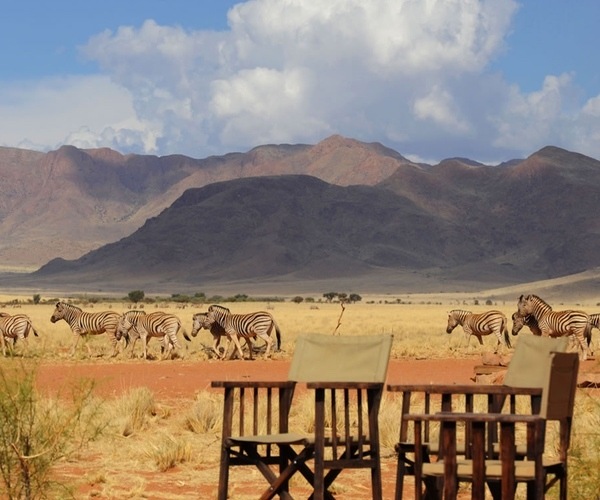
As night falls your isolation becomes ever more apparent. Long shadows slowly creep down from the mountains and the sky changes from brilliant blue to deep royal blue before becoming darkest black, flecked with the light of a thousand stars, and it is all yours, to enjoy in utter splendid isolation.
&Beyond Sossusvlei Desert Lodge
If, however, you have had enough of full isolation and want a little glitz and glamour while you experience the majesty of the Namib Desert, we have the perfect option. A short hop north of Wolwedans is the newly reimagined &Beyond Sossusvlei Desert Lodge, bringing modern chic to the ancient desert.

This is where industrial cool and rugged desert geometry combine to create one of the most striking properties in the whole country. Each of the 12 suites are strung out along the gently curving escarpment, fully glass-fronted so as to not miss a moment of the dramatic surroundings.
Greys, whites, slate, concrete and glass dominate softened with wool, cottons and earthy coir. Puffy sofas sit side by side with scandi-style chairs mirrored in your private outside lounge and plunge pool. While its interiors are oh so stylish, the real star of the show is the view. Everything has been designed to showcase it perfectly, from the glassed in shower offering 180° views to the retractable skylight above the king-sized bed making sure you don’t missing a moment of the celestial performance. For those travelling with children there is even a two-roomed star dune suite, meaning no one has to miss out.
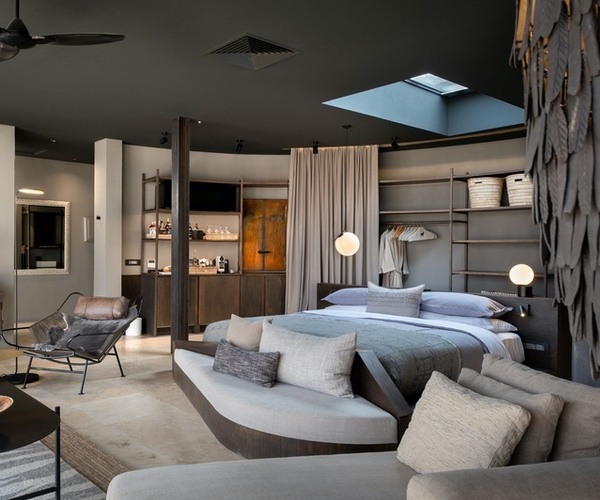
The achingly beautiful design continues in the doubled level main guest areas, offering amenities that would not be out of place in Mayfair or Fifth Avenue. Sip cocktails from the bar, dine at a communal table or find your own secluded spot, explore the temptations of the wine cellar or work up a sweat in the gym, and if you have overindulged there is always the spa for recovery!
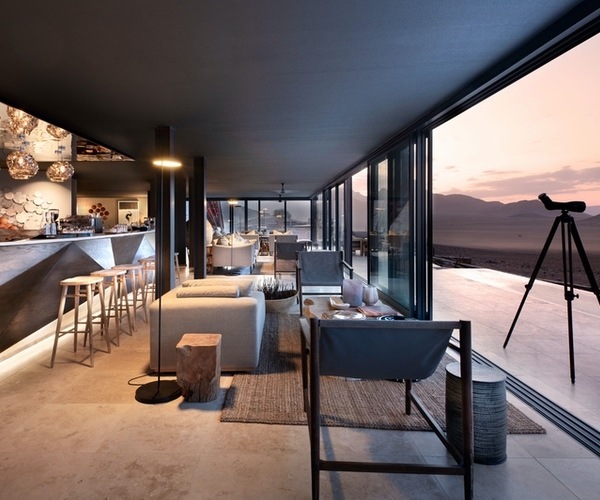
The main attractions of the area are the ever-shifting dunes of Sossusvlei and the neighbouring starkness of the aptly named “Deadvlei”. Guided excursions from the lodge leave as first light makes its presence felt on the distant horizon. As you travel onwards into the heart of the dune fields the rising sun casts ever-changing shadows over the landscape. Towering orange dunes dwarf sporadic camelthorn trees and provide a challenging climb for even the fittest among us.

By late morning the desert sun is high in the sky and there is no escape from its rays. Time to head back to the sanctuary of the lodge until the first gentle waft of cooler afternoon air washes over you. Venture back out and explore a different side of the desert, search for game or learn about the flora that thrives in the shifting sands. Finally head to the hills where sundowner drinks await as the colour of the sky changes by the minute. You may even be lucky enough to dine under the stars in your very own desert fairy circle before heading back “home” for a spot of stargazing at the lodge’s very own on-site observatory with resident astronomer. Don’t stay up too late though, you wouldn’t want to miss sunrise from the back of a quadbike!
Hoanib Skeleton Coast Camp
Venturing ever further north, the sands of the Namib give way to the stone and gravel of the remote Kaokaveld. Here, nestled in a valley created by the once raging and now barely ephemeral Hoanib River, lies Hoanib Skeleton Coast Camp.
Just 8 tents are huddled at the foot of a rocky outcrop on the banks of the dry riverbed. Each en-suite and comfortably furnished in muted earth tones and powered by an almost never-ending supply of solar energy. The less-is-more style of the camp mirrors the ever-present ethos to tread gently and preserve a very fragile ecology.

The lifeblood of the valley is the river, now almost exclusively confined to flowing as a subterranean aquifer, providing enough sustenance for a scattering of albida trees to thrive. The trees and their nutritious pods in turn sustain a variety of wildlife in the driest months, including springbok, gemsbok (oryx), giraffe and even desert-adapted elephants. Of course, where there are grazers and browsers there usually follow predators, and the valley is home to rare desert-adapted lions, cheetahs and brown hyenas.
Explore the area in specially modified 4×4 vehicles in search of the amazingly resilient wildlife, while drinking in some very dramatic scenery. Alternatively explore on foot with your guide to uncover the mysteries that lie hidden in plain sight, from ominous looking scorpions to characterful Namaqua chameleons and enchanting web-footed geckos. When the research teams are in camp guests get a chance to learn about their work, with special emphasis given to the elusive desert-adapted lions.
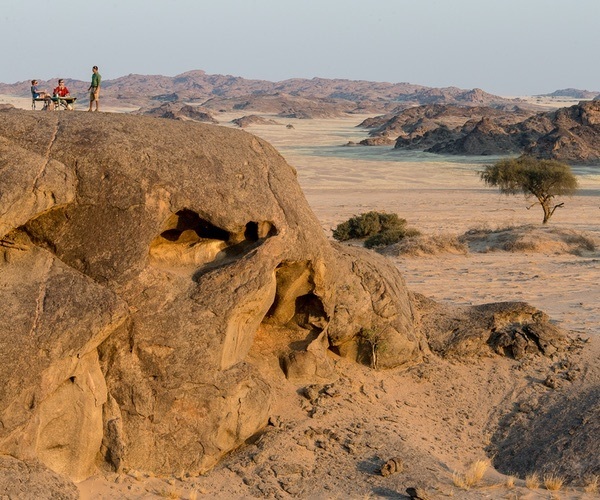
It is not just mammals that manage to exist in these seemingly barren surrounding, but abundant flora and avifauna reveal themselves as you delve deeper. Early morning fog created by the Benguela current bringing cold air from the Southern Ocean to battle the desert’s heated breath, provides life-giving moisture. Thousand-year-old welwitschia mirabilis slump on the ground like worn out mops and vast swathes of landscape bathed in the mysterious glow of a hundred species of lichen. The sky is punctuated with kestrels, buzzards, falcons and eagles while Namaqua sandgrouse and endemic Rüppell’s korhann blend effortlessly into the terrain.

Then, suddenly, like a mirage, there is water. Cresting a desert ridge the vista changes from ochre to a vast ocean of blue ringed by a long black sand beach. You have reached the tempestuous South Atlantic, and the aptly named, Skeleton Coast. The black sands of the beach seemingly shimmer until you realise that it is not sand at all, but a colony of thousands of Cape Fur seals seeking respite from the crashing waves. Closer inspection reveals not everything survives, and the skeletons are revealed. Hulls of great ships lie rusted and forgotten amidst bleached white whale bones and the ever-present shadows of brown hyenas on the lookout for their next meal.
Serra Cafema
Edging ever further north, the creeping sands of the Namib Desert are abruptly halted by the Kunene River, and beyond lies Angola. It is here, at the very furthest reaches of the country, sheltering under the arboreal canopy along the banks of the river that you will find Serra Cafema.
8 stylish wood and glass chalets sit on raised decks under a cooling crown of thatch. Each one taking full advantage of the river setting and resulting forest shade. Inside, sleek design blends with oversized imagery of the local Himba tribe, who are the majority proprietors of all the surrounding land.
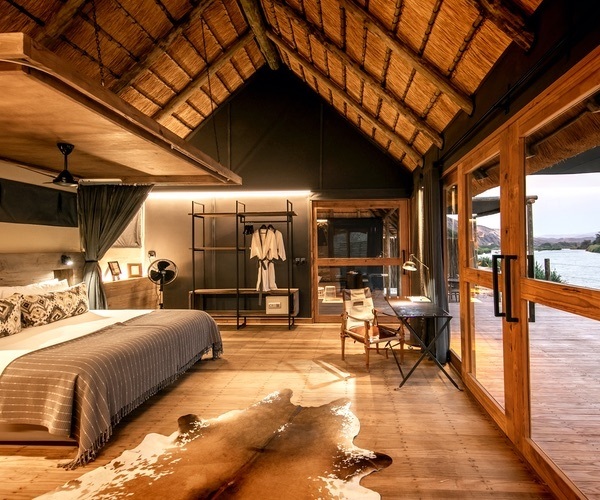
A stay at Serra Cafema is a tale of two worlds. The Kunene is the only permanent water source in the area and creates a verdant, snaking, belt full of life. The world beyond this ribbon of green could not be more different. Crawling desert sands patiently corrode towering granite outcrops and colonise once watery valleys where early morning mist is now the only meagre source of sustenance.
When the water levels permit, head out and explore the meandering river by boat. Green-backed and goliath herons stand like statues waiting for any movement in the water while flashes of golden yellow sparkle in the treeline as lesser-masked weavers busy themselves with nest building. This fertile idyll is, however, not without menace. Every now and again you catch sight of a sizeable Nile crocodile basking on the sandy riverbanks, waiting patiently for something or someone to take a careless step in their direction.

Away from the bounty of the river life is harsh and intermittent. Winds whip along the top of dunes carrying the sands to every corner. Hardy grasses seek what little shade and moisture they can find, providing sustenance to transitory gemsbok (oryx), small herds of springbok and native Hartmann’s mountain zebra. Desert-plated lizards scurry across the baking sand hoping to avoid camouflaged horned-adders, while a Namaqua chameleon bides its time until an errant fly becomes lunch.
In this seemingly desolate land, there remains one of the last truly semi-nomadic tribes of southern Africa, the ovaHimba. The Himba over centuries have learned to adapt and survive in an area in which few others would last. The area around Serra Cafema is the cultural heartland of the Himba people, and guests at the lodge may be lucky enough to encounter tribal members during their stay.

The Himba are some of the most instantly recognisable of all people in southern Africa thanks to their red-orange glow. Living in such harsh condition, exposed all day to an unrelenting sun they smear their bodies with a mixture of butterfat and ochre called otjize. Not only does this give the tribe their characteristic colour, but protects from them from the sun, keeps their skin soft and helps fend off insects. A chance to meet with members of a Himba tribe is a very special honour, as you will be witnessing a rapidly disappearing way of life, born from a time we have long since forgotten.
Little Ongava
For some though, all the breath-taking scenery, wild adventures and iridescent night skies are not enough, and no trip to Africa will be complete without a major dose of its iconic wildlife. Fortunately for them, there is “The Great White Place”, the Etosha National Park, one of Africa’s great wildlife reserves. The park derives its name from the nearly 5,000 sq km great salt pan that lies in its centre, and shimmers in the midday heat like a, well, great white place. While the pan itself is largely lifeless, the magic happens all around the edges!
On the southern border of the park lies the 30,000-ha private Ongava Game Reserve, offering guests the unique advantage of access to both the incredible Etosha National Park and the flexibility of excursions on private land. Although the reserve offers a variety of accommodation, for a lucky few, Little Ongava will be their base.
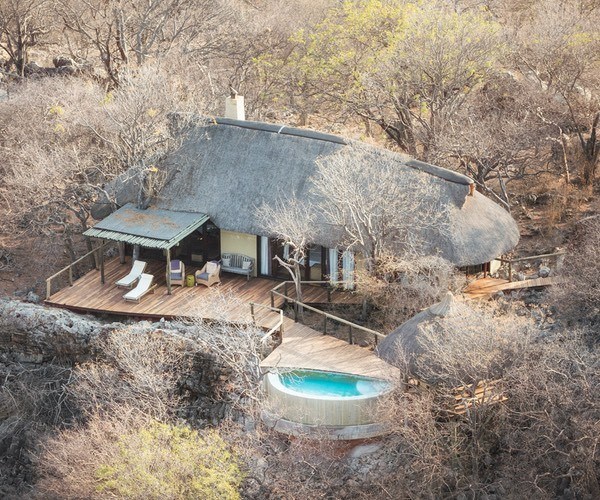
Setting on a rocky hill with endless views over the Ongava plains, there are only three sumptuous suites. Each suite replete with exquisite furnishings, luxury bathrooms, indoor and outdoor showers, expansive deck, shaded “sala” and private plunge pool. The main guest areas share the same dramatic views and the emphasis is on a customised, intimate experience. The camp has its own dedicated vehicle and guide for expeditions in search of Africa’s big game.
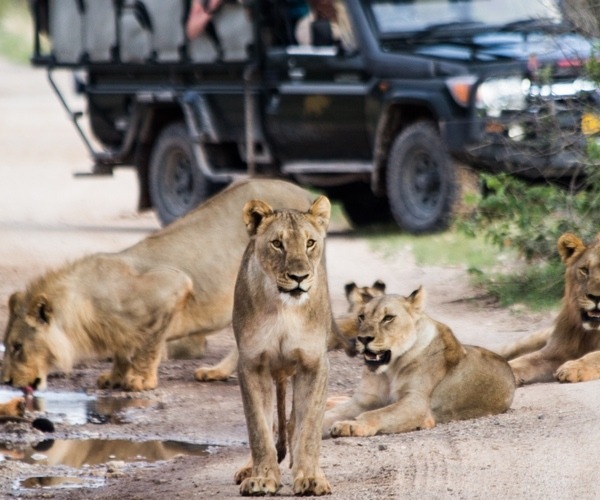
The vast expanse of Etosha and Ongava is largely covered by a rock strewn flat terrain with pockets of hardy mopane trees, the occasional acacia and salt loving grasses and dotted with waterholes and rocky outcrops. From late November to March the rains arrive, creating dark and moody skylines with curtains of rain sweeping across the open savannah visible from miles around. The land briefly turns an iridescent green, flowers open and new life abounds. This is the time to visit when you want to feel like you have the park to yourself, to see baby springbok, zebra foals and gangly wildebeest calves. The skies are filled with migrating birds and even the salt pan fills with brackish water attracting flocks of flamingos and pelicans to its briny shores.
As suddenly as they arrived the rains vanish, the lush grasses turn, the water in the pan evaporates and the whole scene transforms into a whiter shade of grey giving way to an endless sky of cobalt blue. Fine white powdery dust covers everything and lends a slightly eerie feel, like a scene from an old-fashioned spaghetti western. By September it feels like there is not a drop of water left on earth, and yet, this is when some of the best wildlife viewing in Africa takes place. Scenes worthy of National Geographic appear around every corner as creatures great and small descend on the scattered waterholes.

Great billowing dust clouds appear on the horizon, moving ever closer, finally revealing their elephantine secrets at the last moment. Zebras scatter as the grey colossi claim their spot at the bar, their stripes blurring in the heat haze as they plod away. Herds of wildebeest wait patiently while the elephants quench their thirst, very aware that there is a pride of lions resting under the shade of a lone mopane tree, watching their every move. The monotone horizon broken only by a distant journey of giraffe. Like a great theatrical performance as one character exits stage right so another enters stage left and all you need to do it take your seat.
That is the wonderful thing about Namibia, you just have to sit and be still and she will reveal her beguiling secrets to you, and we have all become rather good at sitting and being still in the last few months!
Warwick Blow is Owner of Safari In Style. Safari In Style uses more than 50 years of personal experience to create tailor-made unique journeys through Africa’s finest safari destinations.
